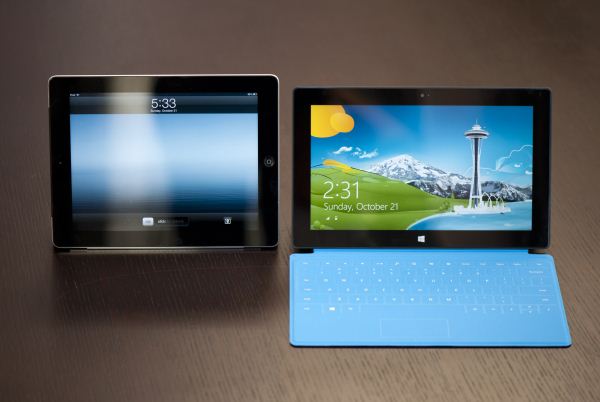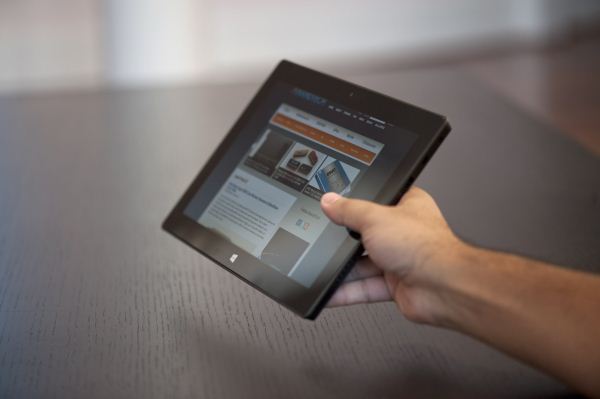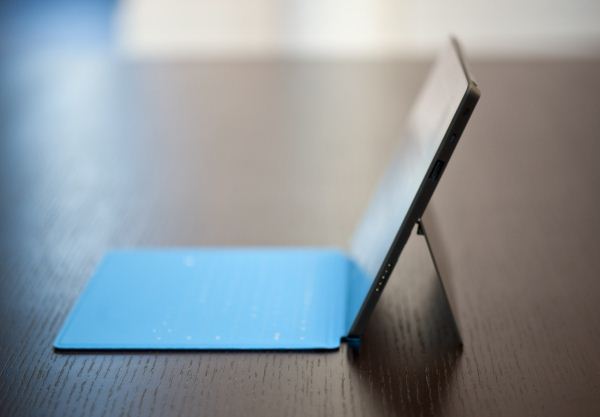Microsoft Surface Review
by Anand Lal Shimpi on October 23, 2012 9:01 PM EST- Posted in
- Tablets
- Microsoft
- Mobile
- Surface
- Windows RT
Surface: Simply Put
Surface is very well built and extremely well designed. It’s easily among the best built products I’ve had the opportunity to handle, and definitely puts a lot of earlier attempts from far more experienced companies to shame. I wouldn’t say that it looks better or worse than the iPad, it’s simply different. I talked about perspectives earlier, Microsoft’s perspective on tablets is a bit more utilitarian than Apple’s and Surface’s design reflects that reality.
Where the iPad is curvy and without any IO expansion, Surface is squared off with 22-degree beveled edges. The iPad features a light aluminum finish while Surface contrasts with its dark Magnesium surface. Not better or worse, just different.
Surface is both larger and heavier than the iPad, both design decisions on Microsoft’s part to built a device that could better deal with Windows RT’s multitasking capabilities as well as make room for a comfortable typing area when used with one of its two keyboard covers.
The added weight is offset by superb internal weight distribution. Microsoft claims a lower moment of inertia by more evenly distributing weight inside Surface’s chassis. I don’t know that I’d consider Surface light but it is very comfortable to carry around. It’s not quite like porting around a pad of paper, but carrying Surface feels very natural.
The focus on weight distribution results in a device that is honestly comfortable to hold in tablet mode and very comfortable to carry around. The more squared design of Surface actually makes in hand feel more like a book than the iPad, which was an early goal for the device.
The chassis is built out of an injection molded Magnesium, which gives it a very different feel to most machined Aluminum or plastic tablets we’ve used in the past. Microsoft calls this process VaporMg (vapor-mag) and I have to say that I’m pleased with the outcome. Surface’s finish is smooth and lacks the same texture that we’ve come to expect from machined Aluminum. The device feels very durable and doesn’t seem to scratch or scuff easily, although I didn’t purposefully try to mar my review unit over the past week. Striking a balance between robustness and light weight is very tricky business when building mobile devices, Surface easily falls on the robust side of the scale without feeling overly heavy. I never felt that the device was too fragile.
The power of Surface is in its flexibility. Microsoft’s talents not as a software developer nor as a parts assembler are what make Surface great here, rather its design and manufacturing intuition. I would’ve expected Surface to come from a company that had much more experience in designing and building tablets and PCs, not from a company that’s traditionally known for putting stickers all over them.
Surface’s flexibility comes from three areas: the tablet itself, the integrated kickstand and the optional Touch/Type covers. In tablet mode, Surface is Microsoft’s take on the new wave of tablets. It delivers the same intimate content consumption experience that you’d get from other tablets but with the added benefits of Windows RT, such as improved multitasking and better task switching.
Surface also features an integrated kickstand, also made out of the same VaporMg process as the rest of the chassis.
Microsoft wants you to be able to quickly transition between notebook, tablet and display modes. It’s rare that I see a goal so well executed. Surface really masters the art of quick transitions between all three modes. I can be in word, typing out this review and quickly switch to a tablet mode where I’m browsing the web with the keyboard cover folded neatly behind the display. If I need to respond to a comment or answer an email, I can just as easily switch back. The kickstand is a necessary part of enabling these quick transitions, and it does its job well.
There’s only one side of Surface that has a cutout for you to easily flick the stand out from its resting place. The kickstand’s range of motion does take some getting used to. It’s spring loaded enough to pop out at good velocity (and strong enough to pinch your skin nicely if you close it on a part of your finger by accident). When deployed it positions the top of Surface away from you at a 22-degree angle, matching the bevel of Surface’s edge.
With a fixed angle of deployment the kickstand doesn’t always deliver the best viewing experience, although it’s usually good enough. The kickstand is perfect for desk use and even for using while reclined on a couch or even in bed. Where it does fall short is if you’re hunched over Surface on an airplane in coach without a lot of room to move the device away from you. In those situations you’re going to find that you’d wish the kickstand could open at a wider angle.
Microsoft is particularly proud of the acoustics and feel of the kickstand. In my experience I felt the kickstand actuated nicely but I don’t know if I’d go so far as to draw the luxury car door comparison. The best way I can put it is the kickstand never feels cheap and doesn’t rattle, it works and gives you the confidence that it’ll always work and not just break after half a year. It’s not often that I find a substantial moving part on a mobile device that I feel is more functional than gimmicky. Surface’s kickstand is definitely a job well done.
The third element of Surface that makes it a very flexible device is also responsible for the splash of color in the design that gives the otherwise business appearance a consumer twist. I’m talking about Surface’s Type and Touch Covers.



















235 Comments
View All Comments
kyuu - Thursday, October 25, 2012 - link
Apple reviews came a week or more after the product was released, not pre-release. Also, they're doing a separate review of WinRT. Unlike Apple, the OS and hardware do not go hand-in-hand (i.e. there are OEMs), so reviewing the hardware and OS separately makes sense.amdwilliam1985 - Tuesday, October 23, 2012 - link
Where is the thumbs up button when you needed one.It's been a while since I've enjoy Anand's writing(too much Apple lately). Read every single word in this great article. My emotion was like a roller coaster reading through the pages. I was sure I'm going to get one at the beginning of the article. And then reading about the "good enough" screen, the power/battery connector, the HDMI port, I was like, maybe next generation. Then moving on with software integration and office, I have my hopes up again. Finally seeing Atom performance preview and the upcoming core x86, I'm definitely holding my horse/breath.
Thanks again for an hour of great reading. I'm in NYC, so I'm planning on seeing the surface on the launch day/evening with my girlfriend.
thomas-hrb - Tuesday, October 23, 2012 - link
I wonder what the maximum size MicroSD card the surface can handle. 32/64 GB is a bit small for a device that I would like to replace my laptop with. But if it could take a 64GB MicroSD like http://au.sandisk.com/products/mobile-memory-produ... then that resolves my issues.Although I intend to hang on for the pro version, as I have a lot oc x86 software I would like to run.
Chris-Simmons - Wednesday, October 24, 2012 - link
All Surfaces use microSDXC so they can take up to 2TB as per the microSDXC spec. I believe the largest microSDXC card available currently is 128GB but that is only for commercial customers, 64GB is the largest for retail. We are just waiting on larger cards to become available.jibz - Tuesday, October 23, 2012 - link
Quick question I didn't see answered in the review: how easy is it to use as a multi user device? One thing that has always bothered me with an iPad or any other tablet is that I can't have different accounts for different family members. So if I install GTA, it'll be available for the kids, I don't have my own bookmarks in my browser, etc. How is Surface/Win RT doing from that point of view?WP7Mango - Wednesday, October 24, 2012 - link
I can give you a detailed answer...Firstly, setting up for multiple users is very easy. The main user is the administrator and the administrator can add further users in the Settings page. Once a user is added, then it's just a case of that new user logging in using either a password, a PIN, or a picture password.
Each user has their own settings, their own apps, their own Start screen layout and background image, their own email accounts, their own contacts in the People hub, their own social network accounts, their own app data, their own bookmarks, etc etc. When one user installs an app, if another user subsequently wants to install the same app then it doesn't get downloaded again - instead, new seperate app settings are created for the new user. So if you are playing a game for example, then your saved games will be seperate from another user's saved games. If you delete a user, only their data is deleted and yours remains intact.
Bottom line is that multi-user works very well.
kyuu - Thursday, October 25, 2012 - link
Thanks for the detailed answer on that!karasaj - Tuesday, October 23, 2012 - link
You mentioned that typing speedily on Surface could bring up some heavy CPU usage: do you think that this really hampers Surface's user experience (would it be an issue) or is it merely an example of MS office 2013 nearly taxing Tegra to its limits?I.E. when typing speedily did CPU usage go up but it remained smooth, or was there a noticeable slowdown? The only things I can imagine doing with Surface are MS office, netflix (HD video), and youtube/IE. Do you think any of those feel too slow/laggy to be detrimental?
VivekGowri - Tuesday, October 23, 2012 - link
Based on my experience with the VivoTab RT (nearly identical hardware/software - Tegra 3 + Windows RT) it's the latter - I saw weirdly high CPU utilization, but no typing lag. Anand mentioned getting some with the Surface, but nothing too drastic if I remember right.karasaj - Tuesday, October 23, 2012 - link
Fantastic. I'm not too worried about high cpu usage as long as there's no lag, although it does seem like that establishes a "lower limit" for RT hardware. Do you think this high cpu usage would have a worse effect on battery life than say the wifi browsing battery life test for example? (I feel like no, but cpu usage shouldn't be too too high there)